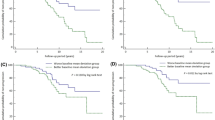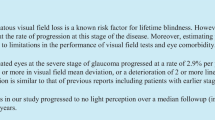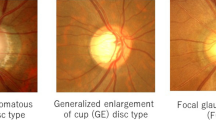Abstract
Some patients with glaucoma do not get worse, some get worse slowly, and some get worse rapidly. It would be desirable to know what characteristics allow accurate prediction of who will not get worse, who will get worse slowly, and who will get worse rapidly. Analyses have been done using various criteria (Table 1). Many of these have been done in an effort to determine what will provide the most sensitive indicator for future worsening of glaucoma.
Access this chapter
Tax calculation will be finalised at checkout
Purchases are for personal use only
Preview
Unable to display preview. Download preview PDF.
Similar content being viewed by others
References
American Academy of Ophthalmology. (1) Primary Open-Angle Glaucoma (1996). (2) Primary Open-Angle Glaucoma Suspect (1995). Preferred Practice Patterns. San Francisco: American Academy of Ophthalmology
The Advanced Glaucoma Intervention Study Group (1998) The Advanced Glaucoma Intervention Study (AGIS): 4. Comparison of treatment outcomes within race. Seven-year results. Ophthalmology 105:1146–1164
Wilson MR, Gaasterland D (1996) Translating research into practice: controlled clinical trials and their influence on glaucoma management. J Glaucoma 5:139–146
Kronfeld PC, McGarry HI (1948) Five year follow up of glaucomas. JAMA 136:957–965
Shiose Y, Kanda T (1974) Quantitative analysis of “optic cup” and its clinical application. Part II. Consideration on clinical cases. Jpn J Clin Ophthalmol. 28:367–374
Jay L, Allan D (1989) The benefit of early trabeculectomy vs conventional management in primary open-angle glaucoma relative to the severity of the disease. Eye 3:528–535
Araujo SV, Spaeth GL, Roth SM, Starita RJ (1995) A Ten-year Follow-up on a Prospective, Randomized Trial of Postoperative Corticosteroids after Trabeculectomy. Ophthalmology 102:1753–1759
Migdal C, Gregory W, Hitchings R (1994) Long-term functional outcome after early surgery compared with laser and medicine in open-angle glaucoma. Ophthalmology 101:1651–1656
Glaucoma Laser Trial Research Group (1990) The Glaucoma Laser Trial (GLT). 2. Results of argon laser trabeculoplasty vs topical medications. Ophthalmology 97:1403–1413
Normal-Tension Glaucoma Study Group (1999) Results of the Normal-Tension Glaucoma Study. Am J Ophthalmol (in press)
Grant WM, Burke JF Jr. (1982) Why do some people go blind from glaucoma? Ophthalmology 89:991–998
Spaeth GL (1994) Reversible changes in the optic disc and visual field in glaucoma. Curr Opinion in Ophthalmol 5:36–56
Spaeth GL, Fellman RL, Starita RL et al. (1985) A new management system for glaucoma based on improvement of the appearance of the optic disc or visual field. Trans Am Acad Ophthalmol Otolaryngol 83:269–284
Burgoyne CF, Quigley HA, Thompson HW, Vitale S, Varma R (1995a) Early changes in optic disc compliance and surface position in experimental glaucoma. Ophthalmology 102:1800–1809
Chandler P, Grant WM (1965) Lectures on glaucoma. Lea and Febiger, Philadelphia, p. 14
Chandler PA (1960) Long-term results in glaucoma therapy. Am J Ophthalmol 49:221–246
Gliklich RE, Steinmann WC, Katz LJ et al. (1987) Primary open-angle glaucoma and visual field changes. Invest Ophthalmol Vis Sci 12:63
Quigley HA, Adicks EM, Green WR, Maumenee AE (1981) Optic nerve damage in human glaucoma II. The site of injury and susceptibility of damage. Arch Ophthalmol 99:635–649
Greenidge KC, Spaeth GL, Traverso CE (1985) Change in appearance of the optic disc associated with lowering of intraocular pressure. Ophthalmology 92(7):897–903
Katz LJ, Spaeth GL, Cantor LB et al. (1989) Reversible optic disc cup** and visual field improvement in adults with glaucoma. Am J Ophthalmol 107:485–492
Editor information
Editors and Affiliations
Rights and permissions
Copyright information
© 1999 Springer-Verlag Berlin Heidelberg
About this paper
Cite this paper
Spaeth, G.L., Hwang, S., Gomes, M. (1999). Disc Damage as a Prognostic and Therapeutic Consideration in the Management of Patients with Glaucoma. In: Gramer, E., Grehn, F. (eds) Pathogenesis and Risk Factors of Glaucoma. Springer, Berlin, Heidelberg. https://doi.org/10.1007/978-3-642-60203-0_16
Download citation
DOI: https://doi.org/10.1007/978-3-642-60203-0_16
Publisher Name: Springer, Berlin, Heidelberg
Print ISBN: 978-3-642-64302-6
Online ISBN: 978-3-642-60203-0
eBook Packages: Springer Book Archive




